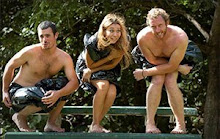
A change in scenery, from lush greens to dry stubby grasses, over the length of the Overlanders Way the moisture is sucked out of the land

Another wwoof contact was leading us to Maronan Cattle Station, south of Cloncurry. Once we passed the Great Dividing Range, we were Outback, and boy did we know it. A new phase in our travels; the open road, land lots of land under a starry sky above, white hot and blinding sunshine. The shimmering heatwaves rise, undulating, distorting the horizon, which was, we were seeing, in all four directions.
The Flinders Highway, part of the Overlanders Way, crosses Queensland from east to west, from Townsville on the Pacific coast to Cloncurry. Named after Captain Matthew Flinders(16 March 1774 – 19 July 1814), one of the most successful navigators and cartographers of his age. In a career that spanned just over twenty years, he sailed with Captain William Bligh, circumnavigated Australia and encouraged the use of that name for the continent. He survived shipwreck and disaster only to be imprisoned for violating the terms of his scientific passport by changing ships and carrying prohibited papers. He identified and corrected the effect upon compass readings of iron components and equipment on board wooden ships and he wrote what may be the seminal work on early Australian exploration A Voyage To Terra Australis.
Leaving Townsville around lunchtime, after 134 km on the road we reached Charters Towers. Stopping only briefly to visit the information centre we passed quickly through this historic town in an attempt to speed up our progress. Charters Towers was the site of a massive gold rush in the late 19th century and grew to become the second largest city in Queensland. Gold was first discovered here in 1870 and in the first 50 years over 6 million ounces of gold was found here. At its peak Charters was home to 25,000 people, 29 crushing mills and 65 hotels, now the population is only half of that with 12,500 people living in the area.


Very soon after leaving town we noticed the lack of any people, buildings of any signs of life for that matter. For the first time so far on this trip we feel the size of Australia, we feels it's flatness, it's baron heat. The wide open spaces were growing wider, and more open. An encompassing panorama engulfed us. Our van motored along the pretty much straight road, a line in the sand really, and any slight bend was cheered, the brow of a hill was treated with whoops of joy. The open road was indeed very open. But, we were excited and thrilled by the prospect. Why, we wondered, were we so excited to see nothing? It’s a vast expanse, a nihilistic landscape, the reality of bone dry; it is relentless same, a shimmering horizon shifting and advancing. But it was an experience none of us had ever had before: that much space and – no one there! With the scenery changing from green to brown we passed through Balfes Creek and Homestead and stopped for the night at a campsite in Pentland. After a feed and a much needed sleep we were off early the next day heading for Hughenden to try and get some much needed fuel. We called into what seemed to be a ghost town called Prairie along the way, but found out that in fact the whole town was attending a funeral at the graveyard just up the road so everything was closed until lunch. The only fuel station was out of fuel and the only person we could see was a dusty looking cowboy sitting outside the saloon doors of the closed pub.

The only fuel station for about 50kms is closed!

Hughenden is situated on the edge of a vast pre-historic inland sea that was home to many terrestrial dinosaurs as well as marine reptiles. The Hughenden and Richmond area of Queensland is well known as dinosaur country and many fossils have been discovered. The advent of the township of Hughenden did not take place until 1876 when the owner of the local station allowed a friend to build a hotel to cater for any travellers passing through on their way to the mining areas around Cloncurry. A store, blacksmith and butcher shop soon followed and Hughenden grew further as it became a railhead for the Great Northern Railway. Today the population is around 1200 and we needed at least one of those people to help us out with fuel.
Using our new found fame in the Townsville Bulletin we asked around for work, before Pat Spiro at the Caltex servo agreed to fill up our tank without the need for us lifting a finger. This meant that after another donated feed at the Holden Café (cheers Helen) we could move on to Richmond.

Helen at the Holden Cafe donates a sandwich and a much needed cup of tea.



The fossil capital of Australia, Richmond is known for its world renowned collection of marine fossils. After arriving here we headed for a designated fossicking site where members of the public are allowed to search for fossils. However with no tools and the midday heat being unbearable we soon returned to town to find somewhere to pitch a tent and then went for a swim in the man made Fred Tritton Lake. This lake is made possible as Richmond sits on top of the Great Artesian Basin. This area used to be a large shallow inland sea but now the water lies underground and allows seemingly parched dusty areas of the outback access to large amounts of subterranean water. Sub artesian water is pumped to the surface traditionally using windmills or in recent years electric pumps, whilst artesian water flows to the surface under natural pressure. This makes the area around Richmond good grazing country. The grazing of sheep and cattle provides the major source of employment and income in the area and this has allowed other businesses such as retail and hospitality to grow around this forming the community.


We spent a night at the Lakeside Caravan Park and had a free meal courtesy of Bob at the mud hut, a huge plate of tasty meat or fish with help yourself veggies and salad satisfied our hunger pangs . We would also like to thank Peter who not knowing us from Adam bought us three cold frosty ones to wet our parched whistles. After tea and damper for breakfast we set off in the direction of Cloncurry to rendezvous with the Mullers at Maronan station. Our eagerness to sample station life and being in no need of a break or fuel we passed through Julia Creek stopping only to splash our thongs in the local conveniences. Julia Creek is home to a small nocturnal marsupial thought to be extinct until 1992. The Julia Creek Dunnart is we are told ‘a feisty yet endearing’ endangered species.

Bob at the Mud Hut

Peter bought us a round of drinks, thanks mate!
On we went again and just before reaching Cloncurry we turned off the Overlanders Way in the direction of McKinlay (made famous in Crocodile Dundee with the Walkabout Creek Hotel).
As arid and foreboding as this environment may be, it is for all that an inspiring place. As far as the eye can see and the mind can muster, the land goes on. Thousands of kilometres uninterrupted, uninhabited, uninhabitable. The thought occurs frequently – what survives out here and how? People have been brave enough to cross this continent and set up home here in the Outback, but always near water. What creatures have adapted to life with little water, limited food, the intense heat and unyielding sun and the dryness it creates? Assuming most of the inhabitants are nocturnal, does everything come alive at night? We can certainly vouch for the fact that daytime is certainly no time to be scurrying or hurrying anywhere. You sweat just
blinking.



Dry cracked earth
Covering this on foot, or on horseback, like the early explorers and settlers did, would be excruciating, surely, arduous and stupefying too. But, clearly, they managed it. Try to imagine the relentless heat, the flies, seeing in front of you what lies ahead for the next few months, and having to find water, carry all you need to survive, with no distinctive markers to get oriented, here looking pretty much the same as there. It would be immense! As challenging as anything could be.

But there are subtleties to the nothing. Where we see emptiness, the Aboriginals saw a landscape full of life, loaded with significance and the means through which they survived alone and undaunted for 40 000 years. We were heading onto a cattle station of 110 000sq acres, not remote by some standards, but certainly as far into the middle of nowhere as we had travelled so far, and we were eager to see a little more of the Outback up close. It would be nearly two more weeks before we picked up our trail again heading for Mount Isa and the Red Centre of
Australia.

A Mobil Roadhouse donates fuel
























1 comment:
Life has many twists and so does a country. Some have floods and drought whilst some have bleak sunless winters with snowstorms that can close airports for days. On an evolving Planet that is expected. Queensland's inland is subject to drought, hot summers, jolly cold winters, fire & flood and rolling plains of native grasslands. You write of Queensland as a dry unyielding land. After rains it can be likened to a "Garden of Eden" in which introduced stock thrive to provide much of the nations income. Unfortunately your writing only mentions dry times. Your story is easy reading with a nice flow but it is a pity you don't spend a few years here so you could have known the "true land"... to get a climate average and also check some statements.
Most carr have fuel tanks with a capacity to travel from Hughenden to Townsville without re-fueling. My car, like many in the inland, has a fuel tank capacity of about 150Lt so we don't expect close fuel stations.
Post a Comment